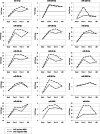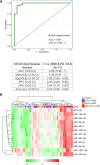Serum MicroRNAs Predict Isolated Rapid Eye Movement Sleep Behavior Disorder and Lewy Body Diseases
- PMID: 35962561
- PMCID: PMC9804841
- DOI: 10.1002/mds.29171
Serum MicroRNAs Predict Isolated Rapid Eye Movement Sleep Behavior Disorder and Lewy Body Diseases
Abstract
Background: Isolated rapid eye movement sleep behavior disorder (IRBD) is a well-established clinical risk factor for Lewy body diseases (LBDs), such as Parkinson's disease (PD) and dementia with Lewy bodies (DLB).
Objective: To elucidate whether serum microRNA (miRNA) deregulation in IRBD can antedate the diagnosis of LBD by performing a longitudinal study in different progression stages of IRBD before and after LBD diagnosis and assessing the predictive performance of differentially expressed miRNAs by machine learning-based modeling.
Methods: Using genome-wide miRNA analysis and real-time quantitative polymerase chain reaction validation, we assessed serum miRNA profiles from patients with IRBD stratified by dopamine transporter (DaT) single-photon emission computed tomography into DaT-negative IRBD (n = 17) and DaT-positive IRBD (n = 21), IRBD phenoconverted into LBD (n = 13), and controls (n = 20). Longitudinally, we followed up the IRBD cohort by studying three time point serum samples over 26 months.
Results: We found sustained cross-sectional and longitudinal deregulation of 12 miRNAs across the RBD continuum, including DaT-negative IRBD, DaT-positive IRBD, and LBD phenoconverted IRBD (let-7c-5p, miR-19b-3p, miR-140, miR-22-3p, miR-221-3p, miR-24-3p, miR-25-3p, miR-29c-3p, miR-361-5p, miR-425-5p, miR-4505, and miR-451a) (false discovery rate P < 0.05). Age- and sex-adjusted predictive modeling based on the 12 differentially expressed miRNA biosignatures discriminated IRBD and PD or DLB from controls with an area under the curve of 98% (95% confidence interval: 89-99%).
Conclusions: Besides clinical diagnosis of IRBD or imaging markers such as DaT single-photon emission computed tomography, specific miRNA biosignatures alone hold promise as progression biomarkers for patients with IRBD for predicting PD and DLB clinical outcomes. Further miRNA studies in other PD at-risk populations, such as LRRK2 mutation asymptomatic carriers or hyposmic subjects, are warranted. © 2022 The Authors. Movement Disorders published by Wiley Periodicals LLC on behalf of International Parkinson and Movement Disorder Society.
Keywords: Parkinson's disease (PD); biomarkers; disease prediction; dopamine transporter single-photon emission computed tomography (DaT-SPECT); isolated REM-sleep behavior disorder (IRBD).
© 2022 The Authors. Movement Disorders published by Wiley Periodicals LLC on behalf of International Parkinson and Movement Disorder Society.
Figures


Similar articles
-
Platelet miRNAs as early biomarkers for progression of idiopathic REM sleep behavior disorder to a synucleinopathy.Sci Rep. 2025 Apr 9;15(1):12136. doi: 10.1038/s41598-025-96926-3. Sci Rep. 2025. PMID: 40204936 Free PMC article.
-
Reduced dopamine transporter binding predicts early transition to Lewy body disease in Japanese patients with idiopathic rapid eye movement sleep behavior disorder.J Neurol Sci. 2020 Jul 15;414:116821. doi: 10.1016/j.jns.2020.116821. Epub 2020 Apr 5. J Neurol Sci. 2020. PMID: 32330698
-
Neuronally Derived Extracellular Vesicle α-Synuclein as a Serum Biomarker for Individuals at Risk of Developing Parkinson Disease.JAMA Neurol. 2024 Jan 1;81(1):59-68. doi: 10.1001/jamaneurol.2023.4398. JAMA Neurol. 2024. PMID: 38048087 Free PMC article.
-
Rapid eye movement sleep behavior disorder: devising controlled active treatment studies for symptomatic and neuroprotective therapy--a consensus statement from the International Rapid Eye Movement Sleep Behavior Disorder Study Group.Sleep Med. 2013 Aug;14(8):795-806. doi: 10.1016/j.sleep.2013.02.016. Epub 2013 Jul 22. Sleep Med. 2013. PMID: 23886593 Free PMC article.
-
From Rapid Eye Movement Sleep Behavior Disorder to Parkinson's Disease: Possible Predictive Markers of Conversion.ACS Chem Neurosci. 2019 Feb 20;10(2):824-827. doi: 10.1021/acschemneuro.8b00388. Epub 2018 Oct 1. ACS Chem Neurosci. 2019. PMID: 30222303 Review.
Cited by
-
A Comprehensive Review of the Role of Biomarkers in Early Diagnosis of Parkinson's Disease.Cureus. 2024 Feb 16;16(2):e54337. doi: 10.7759/cureus.54337. eCollection 2024 Feb. Cureus. 2024. PMID: 38500934 Free PMC article. Review.
-
MicroRNA-361-3p Regulates Autophagy and Apoptotic Processes by Regulating PI3K/Akt Signaling in Parkinson's Disease.Neurochem Res. 2025 Jun 30;50(4):221. doi: 10.1007/s11064-025-04435-6. Neurochem Res. 2025. PMID: 40586827
-
Genome-wide, integrative analysis implicates exosome-derived microRNA dysregulation in chronic insomnia.Sleep. 2025 Jun 13;48(6):zsaf051. doi: 10.1093/sleep/zsaf051. Sleep. 2025. PMID: 40036968 Free PMC article.
-
Mapping Knowledge Landscapes and Emerging Trends in AI for Dementia Biomarkers: Bibliometric and Visualization Analysis.J Med Internet Res. 2024 Aug 8;26:e57830. doi: 10.2196/57830. J Med Internet Res. 2024. PMID: 39116438 Free PMC article.
-
Glutathione Depletion and MicroRNA Dysregulation in Multiple System Atrophy: A Review.Int J Mol Sci. 2022 Dec 1;23(23):15076. doi: 10.3390/ijms232315076. Int J Mol Sci. 2022. PMID: 36499400 Free PMC article. Review.

